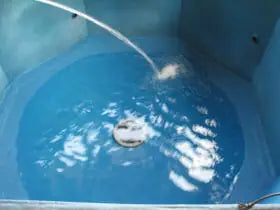Winter Koi Care
Koi fish are Poikilothermic (cold blooded). Their metabolism relies on the temperature of the water that they live in. In the wintertime, when the water in your pond is ice cold, the Koi fish's metabolism slows down to a crawl. They spend most of their time treading water at the bottom of the pond, while sometimes swimming around a bit. They don't sit completely still all winter, they need a little movement to keep their joints from seizing up.
Water reaches its densest point at 39.16°F. In the wintertime, the warmest water is at the bottom of the pond. That is why Koi spend most of their time there.
It would be nice if you could treat a Koi pond like a garden, forgetting about it during the winter, letting it freeze and then taking care of it again in the spring after everything thaws out. Usually people learn the hard way that you shouldn't forget about your pond when they end up with a collection of fish that are floating upside down.
There are several ways to take care of your Koi in the winter:
- Setting up a tank in the garage or house
- Moving the Koi to an indoor pond
- Placing a de-icer and air stone in the pond
- Heating the pond
Winter Tank Setup
Regular fish tanks aren't big enough for Koi fish. A fish tank may work fine when your Koi are small, but they tend to grow faster than you want them to and soon enough your tank will be too small.
Most Koi fish winter tanks are 100 to 1,000 gallons in size. Koi hobbyists use a Polytank or a stock tank. These are much more durable and easier to move than a glass aquarium.
The filtration equipment needed for the winter tank depends on the location it is going to be installed in. If you keep the tank in your garage, you'll need a smaller filter, a bubbler and a de-icer. If you keep the tank in your house or a heated garage, then you'll need a larger filter, a bubbler and a supply of Koi food. The tank will be warm enough to keep them from hibernating.
A tank setup should be somewhat near a source of water and a drain, for when you need to water changes or clean the filter. A power source is required to run the filter equipment too. Make sure you always use de-chlorinated water to fill the tank. The winter tank should be covered by a net, Koi fish like to jump out of a new area. Water changes should be performed weekly or bi-weekly depending on the amount of feed the Koi are receiving and how warm the water is. They can be performed on a monthly basis if the tank is in a garage.
Indoor Koi Pond
A more expensive and more permanent solution is to build an indoor Koi pond. These are usually made from poured concrete or masonry, with a Polyurea liner. The filtration equipment is usually installed in the utility room, away from the pond. Indoor ponds usually incorporate lighting system to illuminate the Koi. The majority of indoor Koi ponds are under 4,000 gallons. It will provide ample room for your Koi to swim in during the long winter months.
Leaving the Koi in the pond
You can leave your Koi in the pond during the winter, as long as it is at least four feet deep. They will require less attention than keeping them in an indoor tank, but you can't completely ignore them though. As the water in your pond gets colder, things will start to happen. Koi will stop eating once the temperature gets below 50°F. They live off the fat their bodies have put on in the late spring and summer. Their movement will slow down, along with their metabolism. The Koi will need less oxygen since their metabolism has slowed. The water will hold more oxygen.
You will need to keep a hole in the ice for gas exchange. The Koi will need fresh Oxygen and the Carbon Dioxide that they exhale will need to vent out. If the CO2 level in the water is allowed to remain at high levels, a buildup of carbonic acid will occur and a pH crash will turn the water acidic. Once that happens, your pond will be too toxic to support most forms of life.
The best ways to keep a hole in the ice are:
- A de-icer
- An air pump and air stone (bubbler)
- Moving water, achieved with an aquarium power head
A de-icer will keep the water temperature around 40°F. It has a sensor that will shut off once the water has reached that temperature.
Pro-Tip: A lot of Koi hobbyists place two de-icers in their pond. One will run and the other will act as a backup in case the primary de-icer fails. It's a good idea to run the de-icers on separate circuits, so if a breaker trips, it won't take out both de-icers.
An air pump and airstone will both aerate the water and keep it moving to help prevent it from freezing. The air pump should be placed in a dry, sheltered area, out of the rain and moisture. The airstone should be suspended no more than twelve inches from the surface of the pond. You do not want to disturb the warm water at the bottom of the pond. Bringing it to the surface will only chill it.
Lets say you leave your waterfall on for that beautiful winter effect, water movement at the surface will keep your pond from freezing. This doesn't mean that you should keep your waterfall running. Not only will the waterfall act as a large heat exchanger (by losing heat from your pond), but it will undoubtedly stir up the warm water at the bottom and will further cool your pond down. Another reason not to use your waterfall to keep your pond open: the waterfall can drain it, really fast. If there is a power outage on a really cold night, the small pools of water that are left in your waterfall after it shuts down will freeze. When the power comes back on, those frozen parts of the waterfall will probably coerce the water into flowing into your yard instead of the pond. You can be left with an empty pond, rescue of your Koi will be hindered by a sheet of ice hanging precariously over them.
The best way to use water movement to keep the ice from covering your pond is to install a pump at the surface. The best type of pumps to use are aquarium power heads. These draw water from the top where they are installed at the then move the water around the surface with a jet nozzle. If your pond does freeze over, don't panic. Your first instinct may be to grab the nearest ax and hack away to rescue your trapped fish. Believe it or not, this will harm your fish and it will make your neighbors wonder why you are hitting your pond with an ax. Koi have an organ, known as the lateral line that detects changes in pressure and movement in the water. Pounding on the ice severely damages this organ and can kill the Koi. The best way to make a hole in the ice is to pour hot, de-chlorinated water on it. This is the quietest method, anything else will make a lot of noise will harm the fish.
Main causes of a pond freezing over:
- Cold Weather
- Power Outages
- Neglect
- Faulty Equipment
- Improper/Incorrectly Installed Equipment
- Unpaid Utility Bills
Heating Your Pond
Another way to keep your Koi in the pond during the winter is to install a heating system. A heating system is made up of a boiler, heat exchanger and a temperature probe. A heating system can be used for:
Keeping the pond in the summer temperature range all year long Preventing the Koi pond from freezing Stopping the large temperature swings that occur in a pond in the spring Heating the water up to get Koi through "Aeromonas Alley" as fast as possible Heating the pond to boost a Koi's immune system to help it when it is sick
Pro-Tip: If you heat your pond, you will also need to keep up on feeding, filter cleaning and water changes (to prevent the pH level from crashing).
Having Koi in the winter doesn't mean that you are stuck at your home instead of escaping to a tropical location. If you leave, have someone responsible check on the pond setup a couple times a day to make sure that everything is alright. Leave detailed instructions on what to do in case there is a Koi emergency. If you bring a laptop, you can always setup a camera system to keep an eye on your Koi wherever you go.




